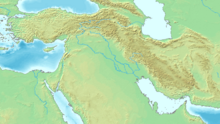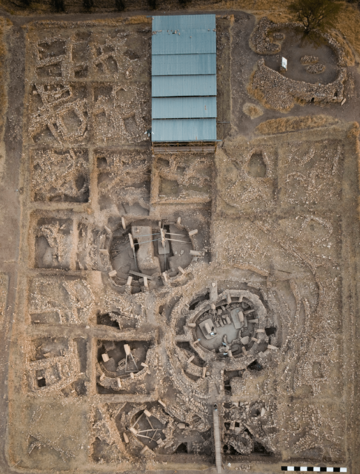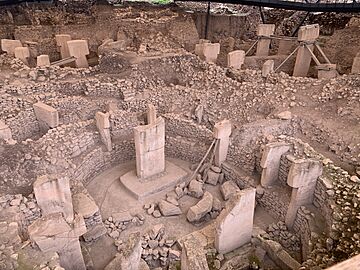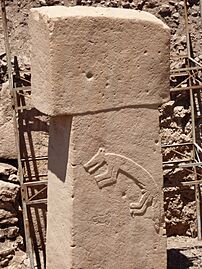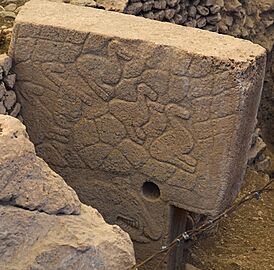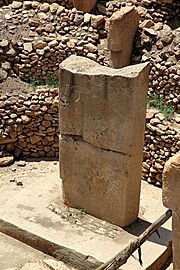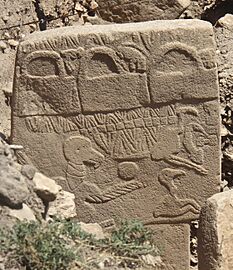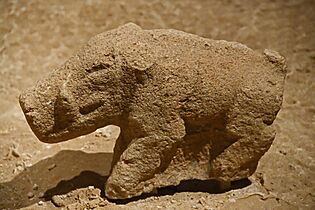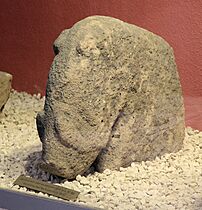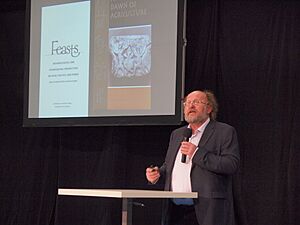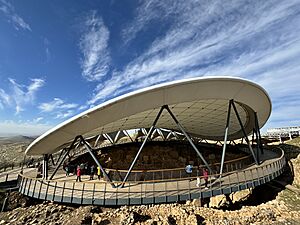Göbekli Tepe facts for kids
|
|
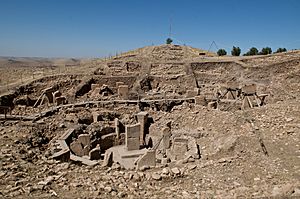
View overlooking the main excavation area of Göbekli Tepe
|
|
| Location | Şanlıurfa Province, Turkey |
|---|---|
| Region | Southeastern Anatolia |
| Coordinates | 37°13′25″N 38°55′18″E / 37.22361°N 38.92167°E |
| Type | Settlement |
| History | |
| Founded | c. BC/BCE (11450 BP) |
| Abandoned | c. BC/BCE (9950 BP) |
| Periods |
|
| Site notes | |
| Discovered | 1963 |
| Excavation dates | 1995–present |
| Archaeologists |
|
| Condition | Well-preserved |
| Ownership | Turkey |
| Public access | no |
| Official name | Göbekli Tepe |
| Type | Cultural |
| Criteria | (i), (ii), (iv) |
| Designated | 2018 (42nd session) |
| Reference no. | 1572 |
| Region | Western Asia |
Göbekli Tepe (pronounced Goh-bek-LEE Teh-peh) is an amazing ancient place in Turkey. Its name means "Potbelly Hill" in Turkish. This site is a very old Neolithic settlement in the Southeastern Anatolia Region. People lived here from about 9500 BCE to at least 8000 BCE.
Göbekli Tepe is famous for its huge circular buildings. These buildings contain massive stone pillars, which are some of the oldest known megaliths (large stones used in ancient structures) in the world. Many pillars have carvings of wild animals and human-like shapes. These carvings give archaeologists clues about ancient religions and art.
The site is a large artificial mound, about 15 meters (49 feet) high. It is full of ancient homes, quarries, and water systems. At first, some thought it was only a religious place for hunter-gatherers. But new discoveries show it was also a settlement with homes and tools for daily life.
Göbekli Tepe was built at the start of the Neolithic period in Southwest Asia. This time saw the first permanent human settlements. Experts debate if farming made people settle down, or if settling down led to farming. Göbekli Tepe, with its big structures but no clear farm evidence, is a key part of this discussion.
The site was first found in 1963. Archaeologist Klaus Schmidt realized how important it was in 1994. He started digging there the next year. After he passed away in 2014, work continued with Istanbul University, Şanlıurfa Museum, and the German Archaeological Institute. In 2018, Göbekli Tepe became a UNESCO World Heritage Site. This means it is a very important place for all of humanity. As of 2021, less than 5% of the site has been uncovered.
Contents
Where Göbekli Tepe is Located
Göbekli Tepe is in the "Stone Hills" area, at the foot of the Taurus Mountains. It looks over the Harran plain and the start of the Balikh River. The site is an artificial mound on a flat limestone plateau. This high spot gave people a great view of the plains below. It also provided easy access to limestone for building and flint for tools.
When Göbekli Tepe was active, the weather was warmer and wetter than today. The area had open steppe grasslands with lots of wild grains like wheat and barley. There were also many grazing animals such as wild sheep, goats, and gazelles. People likely got drinking water from a system that collected rainwater. Channels carved into the rock fed several cisterns (water tanks) underground.
Early Village Life at Göbekli Tepe
Göbekli Tepe was built and used during the earliest part of the Neolithic period in Southwest Asia. This time, called the Pre-Pottery Neolithic (PPN), saw the start of village life. It also brought the first permanent human settlements in the world. Archaeologists have long connected these settlements to the Neolithic Revolution. This was a big change from hunting and gathering to farming.
However, experts still debate if farming caused people to settle, or if settling down led to farming. The Neolithic Revolution in Southwest Asia happened slowly and differently in various places. Some parts of village life appeared thousands of years before farming. The change to agriculture took a long time, with different speeds in different regions.
Evidence shows that the people of Göbekli Tepe were hunter-gatherers. They also ate early forms of wild grains. Tools like grinding stones found at the site suggest they processed a lot of grain. Animal bones show they hunted many gazelles, especially between summer and autumn.
PPN villages usually had groups of stone or mud brick houses. But they also sometimes had large monuments and buildings. These include the tower at Tell es-Sultan (Jericho) and the big circular buildings at Göbekli Tepe. These large structures were likely used for group activities. Building them together helped keep people connected in these growing communities.
The special T-shaped pillars seen at Göbekli Tepe are unique to the Urfa region. But they are found at most PPN sites there. These include Nevalı Çori and Karahan Tepe. Other stone pillars, not T-shaped, have been found at sites further away.
How Old is Göbekli Tepe?
Scientists use Radiocarbon dating to find out how old things are. This method shows that the oldest buildings at Göbekli Tepe were made between 9500 and 9000 BCE. This was near the end of the Pre-Pottery Neolithic A (PPNA) period. The site grew a lot in the early 9th millennium BCE. It was used until around 8000 BCE, or maybe a bit later.
Later, smaller groups of people returned to live among the ruins after the main structures were left empty. Over time, archaeologists have learned more about the exact timeline of Göbekli Tepe. They now know it was used from 9500 to 8000 BCE, covering both the late PPNA and PPNB periods.
Building Over Time
The history of Göbekli Tepe has eight main building phases over at least 1,500 years.
- Phase 1: The earliest homes were round or oval. This shows people lived a settled or semi-settled life.
- Phase 2: Big changes happened to the main circular buildings. New walls were built, including the first T-shaped pillars. More homes were built, still mostly round, but some started to be rectangular.
- Phases 3–5: In the early PPNB, rectangular homes were built on the northern and western slopes. The large circular buildings were also changed and repaired. Later, a big mudslide covered some lower buildings. This caused damage and led to repairs.
- Phases 6 and 7: Building activity slowly decreased. Some old circular buildings were abandoned. New ones might have been built to replace them.
- Phase 8: In the last period, small homes were built within the remains of the old village.
Amazing Architecture
Large Circular Buildings
The first circular buildings appeared around the late 10th millennium BCE. They are between 10 and 30 meters (33 to 98 feet) wide. Their most striking feature is the T-shaped limestone pillars. These pillars are placed evenly inside thick walls made of rough stones. So far, four such circular buildings have been found. Surveys suggest there are 16 more, each with up to eight pillars. This means there could be nearly 200 pillars in total.
The huge stone slabs were brought from pits about 100 meters (330 feet) away. Workers used flint tools to cut them from the limestone rock. These pillars are the oldest known megaliths in the world. Two taller pillars stand facing each other in the center of each circle. We don't know if these circles had roofs. Stone benches for sitting are found inside.
Many pillars have carvings of abstract symbols and animals. The symbols might be sacred signs. The animal carvings show lions, bulls, boars, foxes, gazelles, and donkeys. There are also snakes, other reptiles, insects, spiders, and birds, especially vultures. Vultures are also important in art from other ancient sites like Çatalhöyük.
Few human figures appear in the art at Göbekli Tepe. But some T-shaped pillars have human arms carved on their lower half. This suggests they represent stylized humans or gods. Some pillars even show loincloths. The flat stone on top might be shoulders, meaning the figures were left without heads. We don't know if they were meant to be worshippers, ancestors, or supernatural beings.
The floors in the oldest buildings are made of a material like terrazzo (burnt lime). Other floors are natural rock, with pedestals carved out to hold the central pillars. These early circles were built around 9000 BCE.
Later buildings were rectangular. This shape might have used space more efficiently than circular ones. These rectangular buildings also have T-shaped pillars. This shows they served a similar purpose during the Pre-Pottery Neolithic B (PPNB) period. These rooms often had polished lime floors, like Roman terrazzo. Carbon dating shows they were built between 8800 and 8000 BCE. Some T-pillars, up to 1.5 meters (5 feet) tall, stand in the center of these rooms. One pair with fierce lions gives the name "lion pillar building" to its enclosure.
Mudslides and Repairs
The large circular buildings were located lower down the hill. They were hit by several mudslides during the time Göbekli Tepe was used. One very bad mudslide happened at the end of the early PPNB. It covered one building with dirt and rubble, including burials. This caused a lot of damage. People then made repairs and built terrace walls to try and stop future mudslides. However, another big mudslide likely caused this building to be abandoned around the late 9th millennium BCE. Other buildings faced similar problems, which might have led to new ones being built.
It was once thought that the large buildings were intentionally filled in by people. But this idea is no longer supported by archaeologists.
Homes and Burials
In the earliest times, round or oval homes were built next to the large circular structures. This shows people lived a settled life. Over time, more and more buildings became rectangular. In the last period of use, only small homes were built.
In 2017, parts of human skulls with cuts were found at the site. This might be part of an ancient practice of honoring skulls. Similar prepared skulls have been found at other Neolithic sites.
Carvings and Symbols
The stone pillars at Göbekli Tepe are T-shaped. Many of them have carvings, usually in low relief. Most carvings show animals like snakes, foxes, and boars. There are also gazelles, wild sheep, wild donkeys, ducks, and vultures. The animals are usually male and often look aggressive.
Abstract shapes are also carved, like H-shaped symbols, crescents, and disks. Human figures are rare. However, the T-shape of the pillars themselves looks like a human body. The shaft is the body, and the top is the head. This is supported by some pillars having carved arms, hands, and loincloths.
The two central pillars in each circular building were very special. The ones in Building D show humans with arms and belts. We can't tell their gender for sure, but some think they are men because of the belts. Only one clear carving of a woman has been found.
Some archaeologists believe the many different animals carved on the pillars mean they don't all have one single meaning. Since many are predators, the stones might have been used to ward off evil. Or they could have been totems, representing groups or spirits.
Other Carved Objects
Many smaller carved stones have also been found at Göbekli Tepe. Their carvings are similar to those on the pillars, mostly showing animals, but also humans, usually male.
A "totem pole" was found in one building. It is about 192 cm (6.3 feet) tall. It shows three figures: a predator (bear or big cat), another human-like figure, and a third figure with a head. Snakes are carved on its sides.
Discovering Göbekli Tepe
Before archaeologists studied it, the hill of Göbekli Tepe was known as a sacred place by local people.
The site was first noted in a survey in 1963 by Istanbul University and the University of Chicago. An American archaeologist, Peter Benedict, thought the stone tools found were from the Neolithic period. But he thought the T-shaped pillars were grave markers. Farmers had moved rocks and disturbed the top layers of the site for a long time. Some even tried to break the pillars, thinking they were just ordinary large rocks.
In 1994, German archaeologist Klaus Schmidt was looking for similar sites. He had worked at Nevalı Çori before. He decided to re-examine the Göbekli Tepe site. Local villagers led him there. Schmidt realized the stone slabs were not grave markers, but ancient megaliths. He started digging in 1995 and soon found the first huge T-shaped pillars.
Schmidt led the excavations until he passed away in 2014. Since then, work has continued with Istanbul University, the Şanlıurfa Museum, and the German Archaeological Institute. The current work focuses on carefully documenting and protecting the areas already uncovered.
Protecting the Site
Göbekli Tepe was named a UNESCO World Heritage Site in 2018. This recognized its huge importance as one of the first examples of human-made monumental architecture. As of 2021, only a small part (less than 5%) of the site has been dug up.
There was some discussion in 2018 about conservation work. Some people worried that new walkways were causing damage. But the Ministry of Culture and Tourism said no concrete was used and no damage occurred.
See Also
- Archaeoastronomy
- Boncuklu Tarla
- Gürcütepe
- List of largest monoliths
- Prehistoric religion
- Pseudoarchaeology



